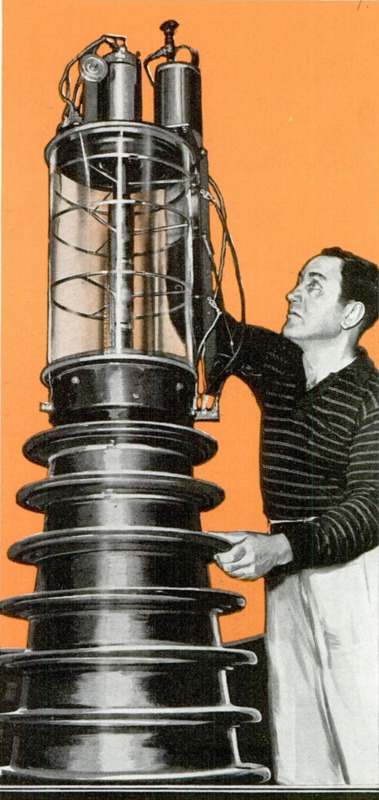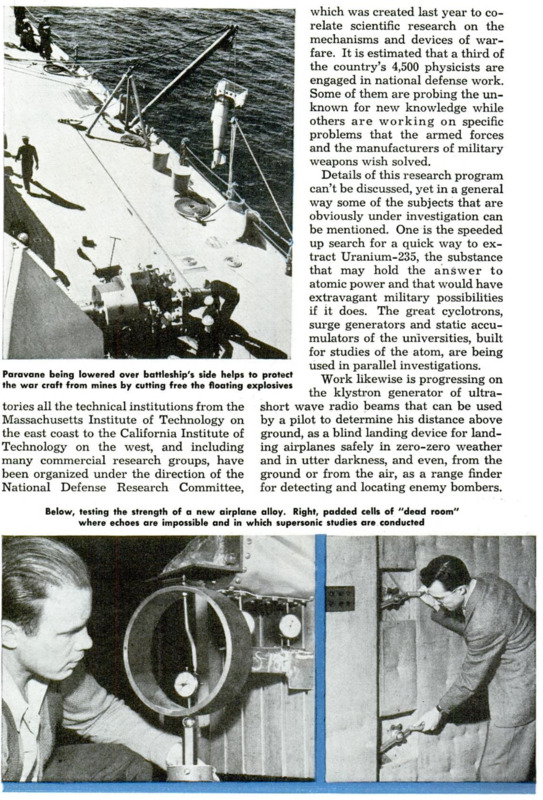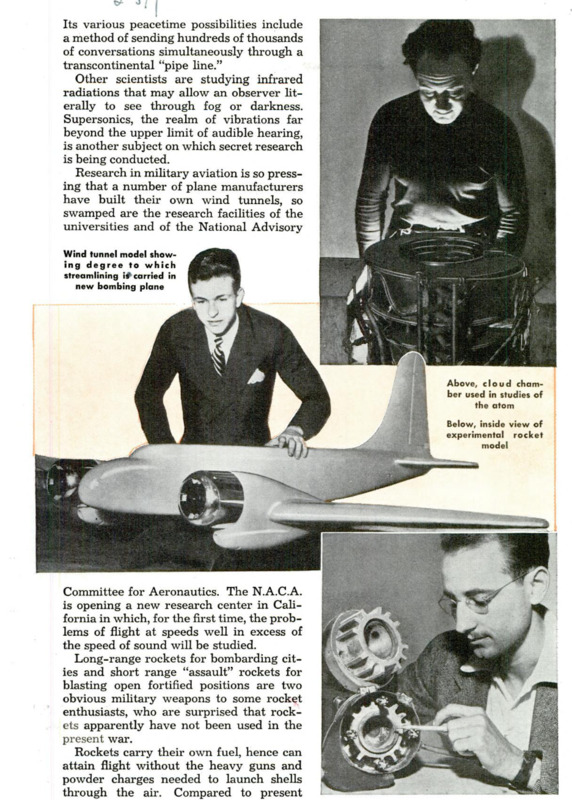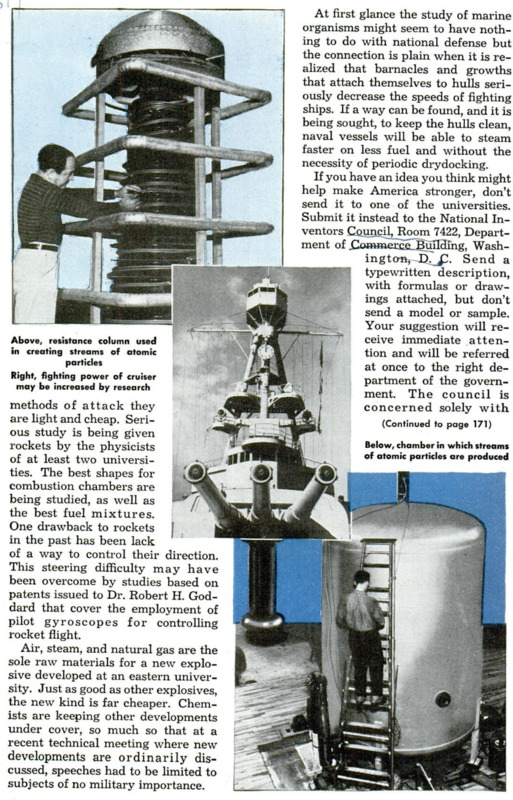SCIENCE has answered the call to arms and today in scores of research laboratories new weapons that may help defend America are being developed and tested. Every branch of knowledge is being explored for its military value by scientists who have been sworn to secrecy. Are death rays, new rocket projectiles and robot bombers being investigated? Authorities will neither affirm nor deny such a leading question, so confidential is the research. For self protection not even the names of the men who are tackling the problems are being revealed. Of course, weapons alone won’t win a war and the present program is concerned with a thousand and one subjects that range all the way from how to make battleships go faster to how to increase the rubber content of the native guayule bush. Such things as adequate vitarftins for a nation at war, and the discovery of adequate substitutes for strategic materials, are just as vital as guns and shells. In this battle of the laboratories all the technical institutions from the Massachusetts Institute of Technology on the east coast to the California Institute of Technology on the west, and including many commercial research groups, have been organized under the direction of the National Defense Research Committee, which was created last year to corelate scientific research on the mechanisms and devices of warfare. It is estimated that a third of the country’s 4,500 physicists are engaged in national defense work. Some of them are probing the unknown for new knowledge while others are working on specific problems that the armed forces and the manufacturers of military weapons wish solved. Details of this research program can’t be discussed, yet in a general way some of the subjects that are obviously under investigation can be mentioned. One is the speeded. up search for a quick way to extract Uranium-235, the substance that may hold the answer to atomic power and that would have extravagant military possibilities if it does. The great cyclotrons, surge generators and static accumulators of the universities, built for studies of the atom, are being used in parallel investigations. Work likewise is progressing on the klystron generator of ultrashort wave radio beams that can be used by a pilot to determine his distance above ground, as a blind landing device for landing airplanes safely in zero-zero weather and in utter darkness, and even, from the ground or from the air, as a range finder for detecting and locating enemy bombers. Its various peacetime possibilities include amethod of sending hundreds of thousands of conversations simultaneously through a transcontinental “pipe line.” Other scientists are studying infrared radiations that may allow an observer literally to see through fog or darkness. Supersonics, the realm of vibrations far beyond the upper limit of audible hearing, is another subject on which secret research is being conducted. Research in military aviation is so pressing that a number of plane manufacturers have built their own wind tunnels, so swamped are the research facilities of the universities and of the National Advisory Committee for Aeronautics. The N.A.C.A. is opening a new research center in California in which, for the first time, the problems of flight at speeds well in excess of the speed of sound will be studied. Long-range rockets for bombarding cities and short range “assault” rockets for blasting open fortified positions are two obvious military weapons to some rocket enthusiasts, who are surprised that rockets apparently have not been used in the present war. Rockets carry their own fuel, hence can attain flight without the heavy guns and powder charges needed to launch shells through the air. Compared to present methods of attack they are light and cheap. Serious study is being given rockets by the physicists of at least two universities. The best shapes for combustion chambers are being studied, as well as the best fuel mixtures. One drawback to rockets in the past has been lack of a way to control their direction. This steering difficulty may have been overcome by studies based on patents issued to Dr. Robert H. Goddard that cover the employment of pilot gyroscopes for controlling rocket flight. Air, steam, and natural gas are the sole raw materials for a new explosive developed at an eastern university. Just as good as other explosives, the new kind is far cheaper. Chemists are keeping other developments under cover, so much so that at a recent technical meeting where new developments are ordinarily discussed, speeches had to be limited to subjects of no military importance. At first glance the study of marine organisms might seem to have nothing to do with national defense but the connection is plain when it is realized that barnacles and growths that attach themselves to hulls seriously decrease the speeds of fighting ships. If a way can be found, and it is being sought, to keep the hulls clean, naval vessels will be able to steam faster on less fuel and without the necessity of periodic drydocking. If you have an idea you think might help make America stronger, don’t send it to one of the universities. Submit it instead to the National Inventors Council, Room 7422, Department of Commerce Building, Washington, D. C. Send a typewritten description, with formulas or drawings attached, but don't send a model or sample. Your suggestion will receive immediate attention and will be referred at once to the right department of the government. The council is concerned solely with suggestions relating to national defense, has nothing to do with patenting inventions, and does not finance experimental work. Whether or not your idea is accepted you are apt to receive little more than a brief acknowledgment that your letter has been received. If a suggestion is turned down, the council won't tell why, as that might furnish a clue to the actual preparations going on behind the scenes. The council is receiving hundreds of suggestions a day and although not more than one in a hundred may be worthwhile, that one idea may be worth waiting for. If you earnestly want to contribute to defense, here’s a tip: don’t just dash off a letter, as one contributor did, suggesting that a death ray with a 100-mile range would be a good thing. Maybe it would. So might artificial clouds that would explode on contact with a bomber, or some sort of “negative” magnetism that would repel torpedoes. Brainstorms such as those are adime a gross. What the council is waiting for is ideas on how to make such dreams come true. If you can work out the main details of a practical idea, trained men will try to make it useful. Paravanes used to ward off mines are the outcome of one idea submitted during the last war. Aside from the research that the universities are doing, 132 of them have added special engineering classes in which some 70,000 men are being trained to fit the special needs of aircraft factories and other manufacturers of armament. The courses are designed to fill the needs of local factories and are based on the fact that with the present rapid expansion of production, large numbers of trained men are needed to fill key jobs and supervisory posts. In most cases the students are employed and are attending classes after working hours. What will be the outcome of the present research program? It will make America stronger and contribute to the benefits of civilization after the war is over. Nearly all military devices have some peacetime uses. Radio and aviation were new when the last war began and much of their usefulness is due to the rapid strides made under the impetus of that national emergency. Every branch of science will benefit from work that is going on today.
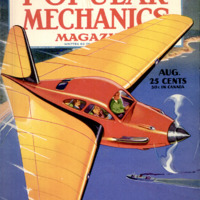 Popular Mechanics, v. 76, n. 2, 1941
Popular Mechanics, v. 76, n. 2, 1941

